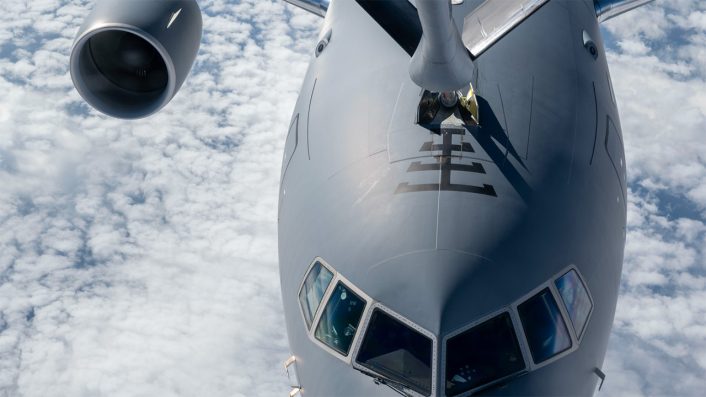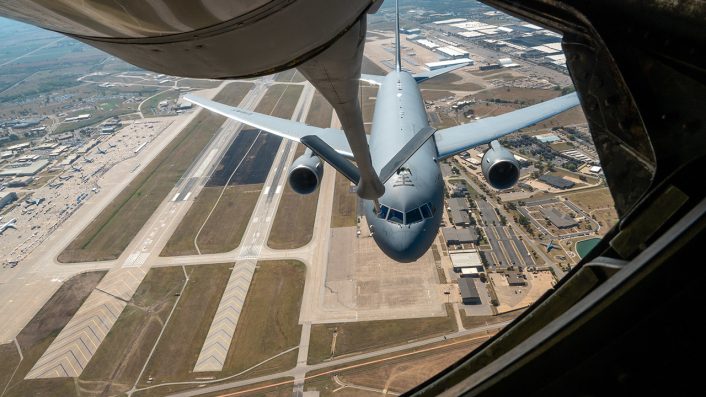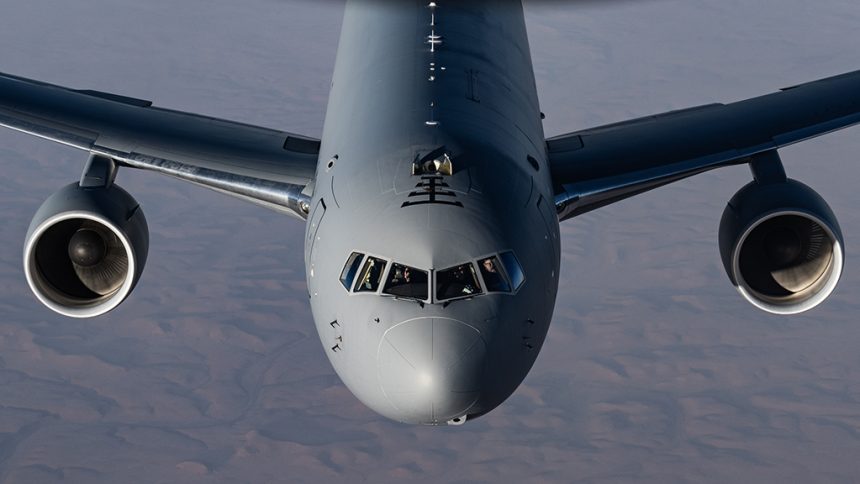The effort demonstrated the ability to support multiple theaters, coordinating with three other bases along the route to pre-position tankers used to refuel the aircraft.
A U.S. Air Force KC-46 Pegasus aerial refueling aircraft executed the type’s world’s first non-stop westbound circumnavigation endurance flight, called Project Magellan, between Jun. 29 and Jul. 1, 2024. The 45-hour flight started and finished at McConnell AFB (Air Force Base), Kansas, after flying over the Pacific Ocean, Asia, Europe and the Atlantic Ocean. McConnell is the first main operating base for the KC-46, with the first aircraft received in 2019.
A statement from the AMC (Air Mobility Command) said the flight was the latest MEO (Maximum Endurance Operation) for the KC-46A, the newest tanker aircraft of the service. During this flight, the KC-46 refueled B-2 Spirit bombers, C-17 Globemaster III airlifters, F-15E Strike Eagles and another KC-46, validating the tanker’s capabilities.

“Air refueling is a very specific process: you have to be at a point at a certain time,” Col. Brent Toth, aircraft commander and 22nd Operations Group’s commander, told Air & Space Forces Magazine after the flight. “And we did that four times all around the world without missing a beat.”
Effectively extending aircraft missions in both time and aircrew, MEOs “enable greater reach over greater distances,” aiding the AMC to “surge personnel, supplies and aircraft to sustain initial operations and project and connect the Joint Force, anywhere in the world,” mentioned the statement.
A US Air Force KC-46A Pegasus executed world’s first 45-hour nonstop, KC-46A Pegasus westbound circumnavigation endurance flight, called Project Magellan, June 29-July 1 starting and finishing at McConnell Air Force Base in Kansas.https://t.co/SPdL7dIZDa pic.twitter.com/e57AJRSbaz
— Ryan Chan 陳家翹 (@ryankakiuchan) July 2, 2024
Further highlighting the surge of personnel and aircraft, the KC-46 flew with a double crew. The nine people on board included four pilots, two boom operators, two flying crew chiefs and a flight surgeon. The four pilots and two boom operators took turns to rest at set intervals, taking advantage of the built-in bunk beds on board the tanker.
Among the pilots was Capt. Cody Donahue, 22nd Operations Group executive officer, who has been planning Project Magellan for months. “Maximum Endurance Operations are all about overcoming the tyranny of distance: with a 48-hour duty day, you can literally fly across the world,” said Donahue.
Support operations everywhere, all at once
Amid a possible conventional war scenario with peer rivals, such long-haul flights would be required to meet refueling requirements at short notice in any part of the world. Particularly, the capability comes in handy when refueling US and Allied aircraft around multiple hotspots.
Warzones have been raging in Europe, and the Middle East, while tensions simmering in the western Pacific for the last decade have reached unprecedented levels. “In an era of Great Power Competition, crews need the ability to operate longer than they have in the past, and Project Magellan is the next step in getting AMC crews experience in the game-changing new construct that is MEO,” further added Capt. Donahue.
The so-called “tyranny of distance” refers to the logistical and economic hurdles created by long distances, in this case the ones between the continental US and the theaters where US forces are deployed. An area where this problem is particularly evident is in the Pacific, where the vast gulfs separating the US’s island bases in the Second Island Chain and the possible maritime warzone around the SCS (South China Sea) would make the resupply of deployed forces and the sustained arming of a war against China very difficult.
Tankers are a key asset to overcome the problem of distance, as highlighted by AMC: “the foundation of Rapid Global Mobility is fuel, provided by tankers.” In fact, the tanker fleet is being increased, as Boeing and the U.S. Air Force signed a $2.3 billion contract for 15 more KC-46As in November 2023, under Lot 10 of the ongoing production. According to GlobalData’s “US Defense Market 2023-2028” report, USAF currently has 75 of the tanker aircraft in service.

Project Magellan is also tied to McConnell AFB’s “ability to Explode Into Theater – or multiple theaters in this case,” since this required coordinating with three other military bases around the world to pre-position several of the wing’s tankers to refuel the KC-46 to fly for 45 hours. These comprised two KC-46’s sent to Andersen AFB in Guam; one KC-135 Stratotanker to RAF Mildenhall, England; and one KC-135 to the Central Command’s Area of Responsibility. One of these KC-135s was deployed from the Utah Air National Guard.
The crew element
Beside the sortie’s duration, the air force also completed it with two “just two basic crews,” said Donahue. “Previously, three pilots were able to fly as an ‘augmented’ crew for up to 24 hours. Going forward, AMC is looking to have a crew of four pilots operating for up to 48 hours.”
The flight therefore came with its share of crew safety measures, as Capt. Jacob Heyrend, 349th Air Refueling Squadron flight surgeon, said one goal was “pushing the brink of human performance.” The crew collaborated with a third-party contractor of elite sports professionals, whose researchers have experience working with sports persons, NASA and other ISS (International Space Station) astronauts.
The contractors utilized tests like the Psychomotor Vigilance Testing, which the crew self-administered at certain points in the sleep-wake cycle and when prompted by Heyrend. “I also performed various ad hoc cognitive assessments like the Montreal Cognitive Assessment. I observed the task response as well to gain a whole person perspective of each crew member.”
The Aviationist recently reported about DARPA’s (Defense Advanced Research Project Agency) AWARE program, which seeks near-IR light-activated stimulants, without the side effects on mood, restorative sleep and mental health.
The flight
The KC-46 Pegasus took off from McConnell AFB at about 4 p.m. (local time) on Jun. 29, with the callsign REACH 046, and headed straight for the Pacific Ocean, where it received gas from another KC-46 off the coast of California. The tanker then flew to Hawaii, where it refueled a C-17 training in the area.
The second leg of the flight took the KC-46 to Guam, receiving fuel along the way by the two tankers that were pre-positioned there. While the aircraft was visible on flight tracking websites throughout the flight, the route in the Indo-Pacific area was not recorded due to a lack of receivers in the area.
The next position available is over the United Arab Emirates, where the tanker was headed to be refueled by two KC-135 tankers, including one from McConnell, flying out of Al Udeid Air Base, Qatar. The KC-46 then met with two F-15E Strike Eagles flying a combat sortie over Iraq, refueling them before parting ways and flying over Turkey, Eastern and Central Europe.
A @USTRANSCOM KC-46A Pegasus from @22ARW executed Project Magellan, a 45-hour endurance mission to circumnavigate the globe including a combat aerial refueling mission of @USAFCENT F-15E Strike Eagles supporting Operation INHERENT RESOLVE in the CENTCOM region. This is the first… pic.twitter.com/zkeG6Qq6e1
— U.S. Central Command (@CENTCOM) July 2, 2024
RCH046 performed a rendez-vous over the United Kingdom with two KC-135s, including one from McConnell, departed from RAF Mildenhall. After the refueling, the KC-46 began the Atlantic crossing for the return leg, crossing again the US border over Michigan.
The tanker was met by another KC-46 from McConnell and together they refueled three B-2A Spirit stealth bombers from Whiteman Air Force Base, Missouri, as well as another KC-46. RCH046 finally landed back at McConnell at around 1 p.m. on Jul. 1, after receiving 454,000 lbs of fuel during four refuelings from seven different tankers, and offloading an undisclosed amount of fuel to contribute to both a combat sortie and training exercises.
https://theaviationist.com/2024/07/02/kc-46-f-16-incident/









